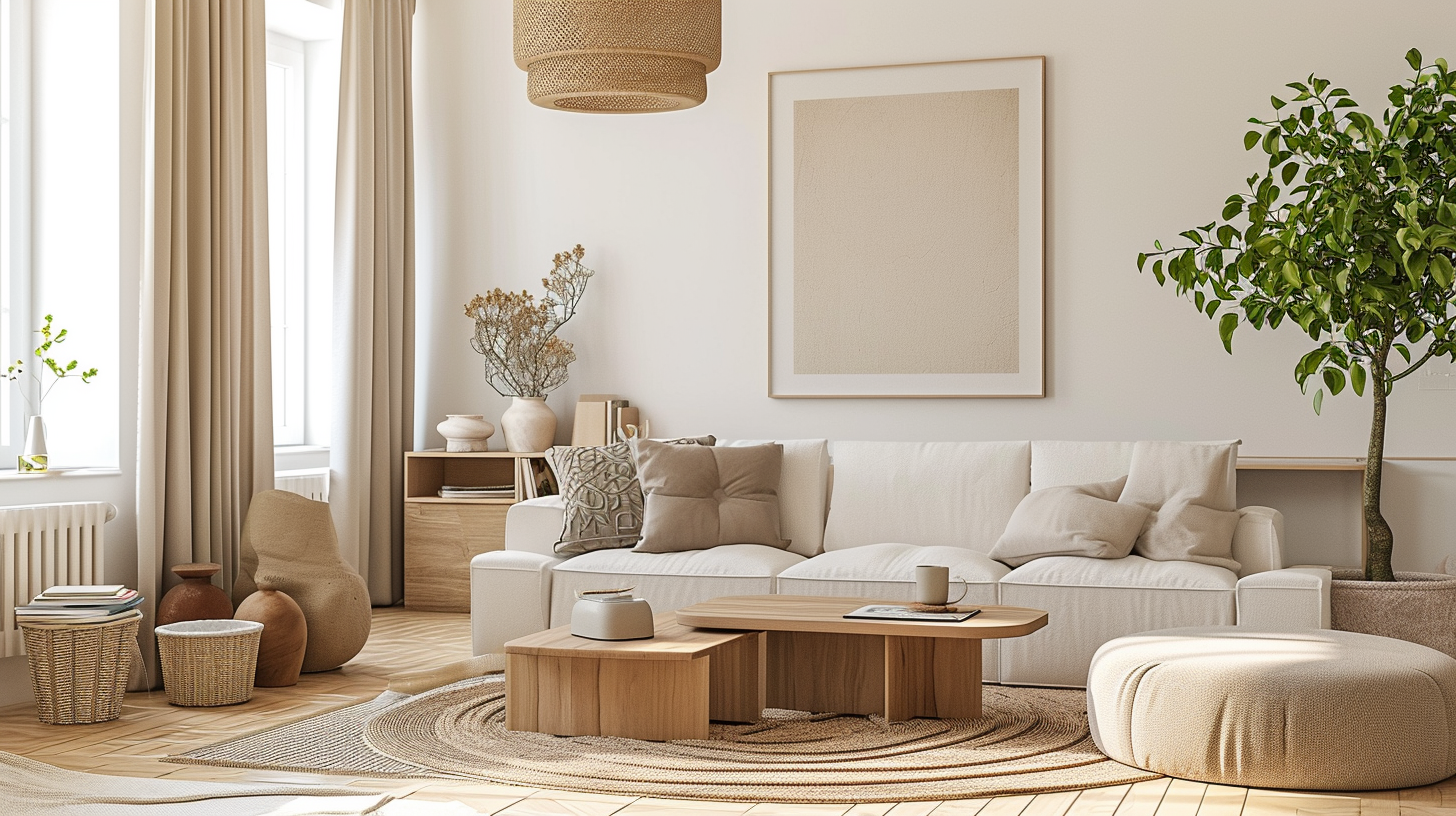I absolutely love the process of home styling and decorating! One design aesthetic that has truly captured my heart is Japandi interiors.
If you’re someone who appreciates the perfect blend of Scandinavian simplicity and Japanese elegance, you’re in for a treat! Join me on this exciting journey where we explore the seamless fusion of these two design worlds.
Welcome to the enchanting realm of Japandi interiors!
You are not interested in the background of japandi interiors? No problem!
What is Japandi Style?
If you’re looking for a design style that combines the best of two worlds, Japandi style is definitely worth checking out. As the name suggests, it’s a fusion of Japanese and Scandinavian design elements that results in a clean, minimalist, and functional aesthetic.
Japandi style is all about simplicity, natural materials, and a sense of calmness and serenity. It’s characterized by a neutral color palette, muted tones, and a focus on texture and contrast. The furniture is often made of wood, with clean lines and simple shapes, while the accessories and decorative elements are kept to a minimum.
One of the key features of Japandi style is the concept of “wabi-sabi,” which is a Japanese philosophy that embraces imperfection and the beauty of the natural world. This means that Japandi interiors often include handmade or artisanal pieces, such as pottery, textiles, or ceramics, that add a touch of warmth and personality to the space.
In addition, Japandi style emphasizes the importance of light and space, with large windows, open layouts, and plenty of natural light. This creates a sense of airiness and openness that is conducive to relaxation and mindfulness.
History of Japandi Interiors

Japandi interiors are a blend of Japanese and Scandinavian design aesthetics. While it may seem like a new trend, the roots of this intertwined aesthetic run deep. Both Japan and Scandinavia have a rich history of design and architecture that has influenced the world for centuries.
Japan’s design philosophy is heavily influenced by Zen Buddhism, which emphasizes simplicity, naturalness, and imperfection. This philosophy is reflected in the use of natural materials such as wood, bamboo, and paper, and the concept of wabi-sabi, which embraces the beauty of imperfection and transience.
Scandinavian design, on the other hand, is characterized by simplicity, functionality, and minimalism. It is rooted in the harsh Nordic climate, where people have to make the most of limited resources. Scandinavian interiors are known for their use of light colors, natural materials, and clean lines.
The term ‘Japandi’ was coined in recent years to describe the fusion of these two design styles. The result is a harmonious blend of the warmth and coziness of Scandinavian interiors with the simplicity and elegance of Japanese design.
Japandi interiors have gained popularity in recent years due to their timeless and minimalist aesthetic. They are a perfect balance of form and function, and their simplicity makes them ideal for small spaces. If you’re looking to create a peaceful and serene home that is both functional and beautiful, Japandi interiors are definitely worth considering.
Key Elements of Japandi Interiors
If you’re looking to create a cozy and minimalist interior design, Japandi style might be what you’re looking for. Japandi interiors are a fusion of Japanese and Scandinavian design styles, which are known for their simplicity, functionality, and elegance. In this section, we’ll explore the key elements of Japandi interiors that make them so unique and popular.
Minimalism

One of the most important elements of Japandi interiors is minimalism. This means that the space is uncluttered, with only a few carefully selected items. Japandi style emphasizes quality over quantity, and every piece of furniture or decor should have a purpose. To achieve a minimalist look, consider using simple lines, neutral colors, and natural materials.
Natural Materials

Another essential element of Japandi interiors is the use of natural materials. This includes wood, stone, bamboo, and other materials that are found in nature. Natural materials add warmth and texture to a space, and they also create a sense of harmony with the environment. When choosing furniture and decor for your Japandi interior, look for pieces that are made from natural materials and have a simple, organic design.
Contrasts

Japandi interiors also incorporate contrasts to create visual interest. This means combining different textures, colors, and materials to create a harmonious and balanced space. For example, you might pair a smooth, white ceramic vase with a rough, textured wood table. Contrasts can also be achieved by combining different design styles, such as a Japanese shoji screen with a Scandinavian-style sofa.
Neutral Colors
Finally, Japandi interiors typically use a neutral color palette. This includes shades of white, gray, beige, and black, which create a calming and serene atmosphere. Neutral colors also allow natural materials and textures to stand out, and they provide a backdrop for pops of color in the form of plants or artwork. When choosing colors for your Japandi interior, stick to muted tones and avoid bright or bold hues.
Furniture and Furnishings in Japandi Style

Japandi interiors are all about blending the minimalist aesthetics of Scandinavian design with the traditional elegance of Japanese design. The result is a unique style that emphasizes simplicity, functionality, and natural elements. When it comes to furniture and furnishings, Japandi style combines the best of both worlds, creating a harmonious balance between form and function.
Characteristic furniture pieces
In Japandi interiors, furniture is often made from natural materials like wood, bamboo, and rattan. The use of raw materials is a major theme, and playing with different types and stains of wood to add tonal interest is a signature of Japandi style. Furniture pieces are often low to the ground, with clean lines and simple shapes that emphasize function over form.
Characteristic furniture pieces in Japandi style include low-profile platform beds, modular shelving units, and minimalist seating like floor cushions and low-backed chairs. The use of sliding doors and screens is also common in Japandi interiors, adding a touch of traditional Japanese design to the space.
Functional aesthetics

One of the key principles of Japandi style is the fusion of beauty and functionality. Furniture pieces are designed to be practical and versatile, with multi-functional features that make the most of limited space. For example, a low-profile platform bed might have built-in storage drawers underneath, or a modular shelving unit might double as a room divider.
Japandi interiors also emphasize the importance of natural light and greenery. Plants like ferns and bonsai trees are often used as decor, adding a touch of nature to the space. Window treatments are kept minimal to allow natural light to flood the room, while soft, neutral colors like beige, gray, and white create a calming, peaceful atmosphere.
How to Implement Japandi Style in Your Home

If you’re looking for a way to create a relaxing and peaceful atmosphere within your home, then Japandi interiors might be the perfect style for you. Japandi style is a combination of Japanese minimalism and Scandinavian design, resulting in a clean, simple, and cozy aesthetic that promotes a sense of calm and tranquility.
Furniture Selection
When it comes to furniture selection, Japandi style is all about simplicity and functionality. Opt for furniture with clean lines, minimal ornamentation, and natural materials such as wood, bamboo, and linen. Furniture pieces should be multifunctional and space-saving, such as a low-lying platform bed or a storage ottoman that doubles as a coffee table.
Decor Elements

Incorporate natural elements into your decor, such as indoor plants, woven baskets, and stone accents. Japandi style also emphasizes the use of organic textures and materials, such as raw wood, rattan, and natural fibers. Keep decor minimal and purposeful, avoiding clutter and unnecessary ornamentation.
Color Palette
Japandi style is characterized by a neutral color palette, with shades of white, beige, gray, and black dominating the space. Add warmth and texture to the room with natural wood tones, warm metallic accents, and soft textiles in muted colors.
My Step-by-step guide for japandi interiors!
1.) Declutter Your Space
Begin by decluttering your living area. Remove unnecessary items and keep only the essentials. Embrace a “less is more” mindset.
2.) Choose Natural Materials
Select furniture and decor made from natural materials such as wood, stone, and bamboo. These materials contribute to the warmth and simplicity characteristic of Japandi design.
3.) Opt for Low-Profile Furniture
Invest in low-profile furniture with clean lines. Consider items like platform beds, sleek sofas, and minimalist coffee tables to maintain a sense of openness and simplicity.
4.) Embrace Neutral Color Tones
Stick to a neutral color palette, including earthy tones and muted pastels. Whites, grays, and beige can serve as a foundation, allowing for subtle pops of color through accents.
5.) Introduce Contrasts
Create visual interest through the use of contrasts. Pair light and dark elements, such as dark furniture against a light backdrop, or incorporate black accents to enhance the overall aesthetic.
6.) Incorporate Functional Decor
Choose decor items that serve a purpose while maintaining a clean aesthetic. For example, use woven baskets for storage, and opt for multi-functional furniture pieces to maximize utility.
7.) Integrate Indoor Plants
Bring nature indoors with the addition of houseplants. Consider bonsai trees, bamboo, or simple potted plants to add a touch of greenery and enhance the connection with the natural world.
8.) Focus on Lighting
Use soft, natural lighting to create a calm and inviting atmosphere. Consider pendant lights, floor lamps, or natural light sources to illuminate your space in a gentle and harmonious way.
9.) Personalize with Handcrafted Items
Infuse your space with personality through handcrafted items and artisanal decor. Handwoven textiles, ceramics, and pottery can add a touch of uniqueness to your Japandi-inspired interior.
10.) Maintain Open Spaces
Foster a sense of openness by leaving ample space between furniture. Avoid overcrowding the room and allow for easy movement, contributing to the overall tranquility of the space.
Budget-friendly options

Japandi style can be achieved on a budget by repurposing existing furniture pieces, shopping at secondhand stores, and incorporating DIY decor elements. Look for furniture pieces made of natural materials, such as wood and bamboo, and add warmth and texture to the room with soft textiles and warm metallic accents.
DIY ideas for Japandi decor
Create your own Japandi-inspired decor pieces, such as a woven wall hanging or a macrame plant hanger. Use natural materials such as cotton rope, jute twine, and wooden beads to add texture and warmth to the room. Repurpose old furniture pieces by sanding and staining them to achieve a natural wood finish.
Examples for Japandi Interior
If you’re looking to create a minimalist, cozy, and functional living space, Japandi interiors are a great choice. Japandi is a design trend that combines the simplicity and elegance of Japanese design with the warmth and comfort of Scandinavian style. Here are some examples of how you can incorporate Japandi elements in your home.
Do you like the article? You might also be interested in our article about modern art in Japan and our article about Japans beautiful nature. Just Click me!
Fast Travel Links (Just Click me):
Japandi in the Living Room
Elevate your living room with Japandi style: neutral tones, natural materials like wood and stone, modern furniture with clean lines, and soft textiles. Add a touch of nature with a bonsai tree or flowers for vibrant living.

Japandi in the Bedroom
Transform your bedroom into a serene retreat with Japandi style. Opt for a low platform bed with a simple wooden frame and soft, muted bedding. Embrace natural materials like cotton, linen, and wool for sheets and blankets. Maintain a clutter-free space with minimalist storage like a wooden chest or wall-mounted shelf. Infuse personality with art or decorative items such as a ceramic vase or woven basket.
Japandi in the Kitchen
Enhance your kitchen with Japandi style for a functional and efficient workspace. Opt for a clean and simple layout with ample storage and natural materials like wood and stone. Keep utensils organized and within reach. Choose elegant tableware such as ceramic plates and wooden bowls. Infuse freshness with greenery like a herb garden or potted plant.
Japandi in the Bathroom
Infuse Japandi style into your bathroom for a spa-like retreat. Use natural materials, opt for minimalist storage, and choose simple fixtures in neutral tones. Add soft textiles and subtle greenery, like bamboo or fresh flowers, for a calming ambiance.

My absolute must haves when furnishing in japandi style!
In the realm of Japandi interiors, my absolute must-haves take center stage! I adore the delicate interplay of natural colors, creating a timeless elegance that defines my space with serenity and sophistication. The fusion of bright expanses and enigmatic, dark accents achieves a captivating harmony that’s non-negotiable for me.
Dried flowers in dark vases are a top priority, not just for the organic textures they bring but also for that touch of dramatic flair I crave. The interplay of light-filled rooms and mysterious, deep-toned highlights is an essential dance that imparts balance and intrigue to my living space. Abstract artworks on my walls act as poetic expressions, seamlessly complementing the Japandi aesthetic and narrating stories of style and substance.
A cherished favorite is the incorporation of greenery, especially plants, adding a refreshing touch while emitting a calming vibe throughout the room. For me, Japandi interiors transcend mere design; they signify a daily infusion of tranquility and aesthetic joy.
Frequently asked Questions
What defines Japandi interiors?
Japandi interiors blend the clean aesthetics of Japanese minimalism with the cozy warmth of Scandinavian design. Characterized by minimalistic forms, natural materials, and a harmonious color palette, it creates a unique and timeless style.
What colors work well in Japandi interiors?
Earthy tones like gray, beige, and brown dominate Japandi interiors. Accents in soft pastel colors can introduce subtle freshness, while black and white provide contrast and balance.
What furniture complements Japandi interiors?
Japandi-style furniture features clean lines, functional design, and high-quality craftsmanship. Opt for pieces made from natural materials like wood and choose simple forms for a timeless elegance.
How can I create a serene atmosphere in Japandi interiors?
Minimize clutter, embrace minimalist decor, and maximize natural light sources. Incorporate plants, especially bonsai or gentle grasses, to connect with nature and cultivate a calming atmosphere.
Let us know in the comments what you think of our suggestions for Japandi Interiors and what are your favorites are!
































































